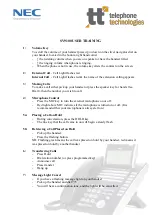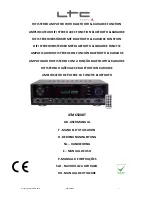
- 1-4 -
❏
ESD PRECAUTIONS
• Electrostatically Sensitive Devices (ESD)
Some semiconductor (solid state) devices can be damaged easily by static electricity. Such components
commonly are called Electrostatically Sensitive Devices (ESD). Examples of typical ESD devices are integrated
circuits and some field-effect transistors and semiconductor chip components. The following techniques should
be used to help reduce the incidence of component damage caused by static electricity.
1. Immediately before handling any semiconductor component or semiconductor-equipped assembly, drain off
any electrostatic charge on your body by touching a known earth ground. Alternatively, obtain and wear a
commercially available discharging wrist strap device, which should be removed for potential shock reasons
prior to applying power to the unit under test.
2. After removing an electrical assembly equipped with ESD devices, place the assembly on a conductive sur-
face such as aluminum foil, to prevent electrostatic charge buildup or exposure of the assembly.
3. Use only a grounded-tip soldering iron to solder or unsolder ESD devices.
4. Use only an anti-static solder removal device. Some solder removal devices not classified as "anti-static" can
generate electrical charges sufficient to damage ESD devices.
5. Do not use freon-propelled chemicals. These can generate electrical charges sufficient to damage ESD
devices.
6. Do not remove a replacement ESD device from its protective package until immediately before you are
ready to install it. (Most replacement ESD devices are packaged with leads electrically shorted together by
conductive foam, aluminum foil or comparable conductive materials).
7. Immediately before removing the protective material from the leads of a replacement ESD device, touch the
protective material to the chassis or circuit assembly into which the device will by installed.
CAUTION : BE SURE NO POWER IS APPLIED TO THE CHASSIS OR CIRCUIT, AND OBSERVE ALL
OTHER SAFETY PRECAUTIONS.
8. Minimize bodily motions when handing unpackaged replacement ESD devices. (Otherwise harmless motion
such as the brushing together of your clothes fabric or the lifting of your foot from a carpeted floor can gen-
erate static electricity sufficient to damage an ESD device).
•
CAUTION. GRAPHIC SYMBOLS
THE LIGHTNING FLASH WITH APROWHEAD SYMBOL. WITHIN AN EQUILATERAL TRIANGLE, IS INTENDED TO
ALERT THE SERVICE PERSONNEL TO THE PRESENCE OF UNINSULATED “DANGEROUS VOLTAGE” THAT
MAY BE OF SUFFICIENT MAGNITUDE TO CONSTITUTE A RISK OF ELECTRIC SHOCK.
THE EXCLAMATION POINT WITHIN AN EQUILATERAL TRIANGLE IS INTENDED TO ALERT THE SERVICE PER-
SONNEL TO THE PRESENCE OF IMPORTANT SAFETY INFORMATION IN SERVICE LITERATURE.
Summary of Contents for LX-U250A
Page 7: ... 1 6 ...
Page 29: ... 2 22 INTERNAL BLOCK DIAGRAM of ICs NJW1190 BLOCK DIAGRAM ...
Page 30: ... 2 23 PIN FUNCTION SSOP44 ...
Page 31: ... 2 24 PIN FUNCTION QFP48 P1 ...
Page 35: ... 2 28 PIN DESCRIPTION ...
Page 36: ... BLOCK DIAGRAM 2 29 2 30 ...
Page 37: ...2 31 2 32 WMA USB BLOCK DIAGRAM ...
Page 38: ...2 33 2 34 SCHEMATIC DIAGRAMS MAIN SCHEMATIC DIAGRAM ...
Page 39: ...2 35 2 36 FRONT SCHEMATIC DIAGRAM ...
Page 40: ...2 37 2 38 POWER SCHEMATIC DIAGRAM ...
Page 41: ...2 39 2 40 DECK SCHEMATIC DIAGRAM ...
Page 42: ...2 41 2 42 CD SCHEMATIC DIAGRAM ...
Page 43: ...2 43 2 44 USB SCHEMATIC DIAGRAM ...
Page 44: ...2 45 2 46 WIRING DIAGRAM ...
Page 45: ...2 47 2 48 PRINTED CIRCUIT DIAGRAMS MAIN P C BOARD ...
Page 46: ...2 49 2 50 FRONT P C BOARD ...
Page 47: ... CDP P C BOARD COMPONENT SIDE 2 51 2 52 ...
Page 48: ...2 53 2 54 CDP P C BOARD SOLDER SIDE ...
Page 49: ...2 55 2 56 LINEAR POWER ...
Page 53: ...3 5 3 6 ...
Page 54: ... 4 1 MODEL LXS U250 850 851 860 852 857 856 855 854 853 861 SECTION 4 SPEAKER SECTION ...
Page 55: ... 4 2 ...






































